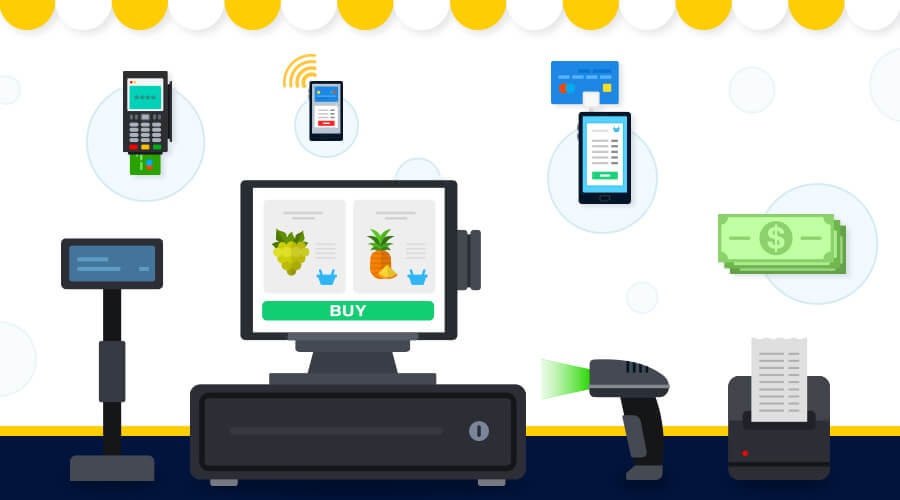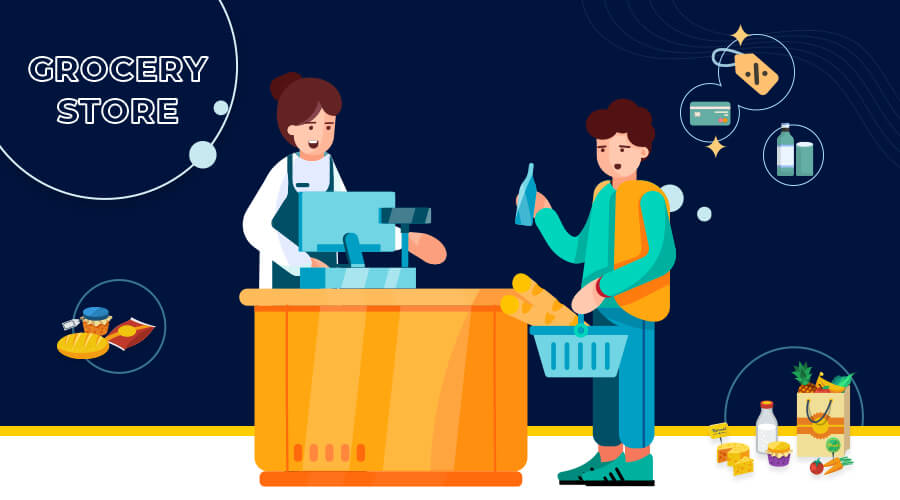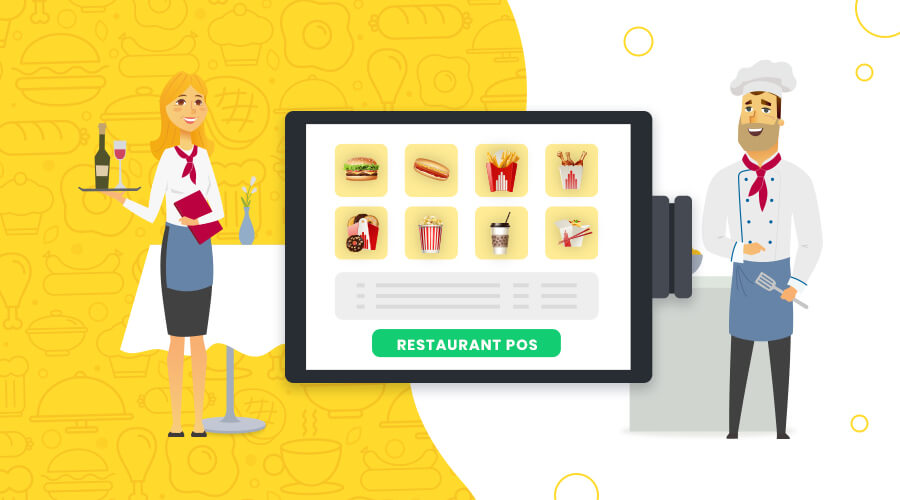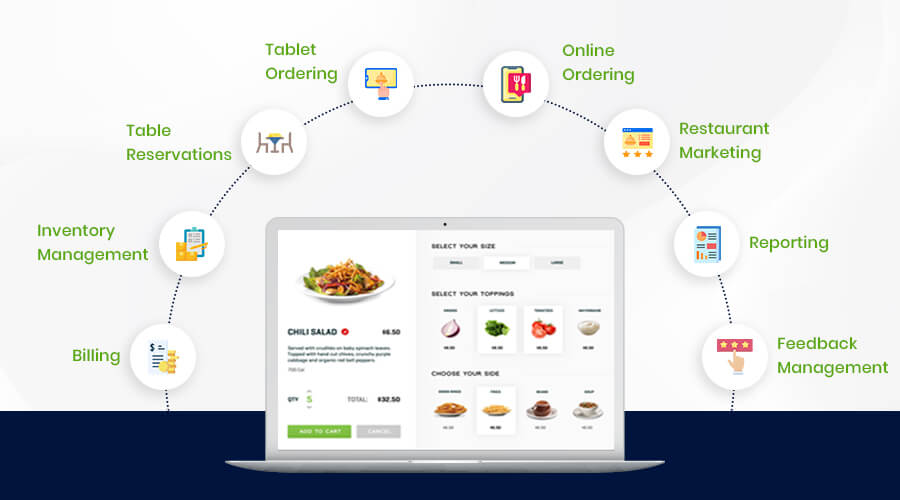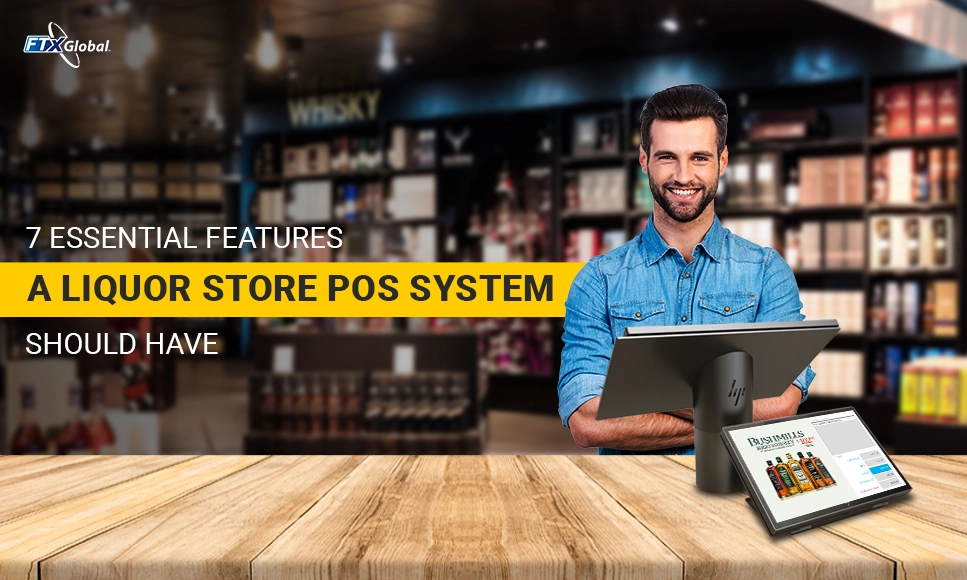
Liquor stores need a point of sale system to function seamlessly; it’s a fact that everyone knows. However, not everybody knows the essential things a complete liquor store POS system must have. A complete liquor store POS system has the ability to manage inventory, orders, customer experience, employees, pricing on digital signage, billings, payments, and many more aspects of liquor store businesses. To help liquor store owners who are confused about what to look for in a POS system for a liquor store, FTx Global has curated a lot of the top 7 must-haves.
Top 7 Must-Haves for a Liquor Store POS System
-
The Ability to Track Inventory Flawless and Manage the Entire Supply Chain
Tracking inventory efficiently solves half of the problems for a liquor store. There are several brands with several products, as well as different editions. Thus, it becomes difficult to track the journey of each product and its availability. Moreover, online liquor sales have become quite confusing in consolidating online sales with offline sales. You need a system that can help you centralize your inventory and manage the in-store inventory of multiple stores. And that’s what you should look into as a liquor store point of sale system in modern times. A modern liquor POS system will help you manage your entire supply chain right from when a product is unloaded in the warehouse (in the case of large stores that keep a warehouse) to when the liquor is sold.
-
The Capability to Sell Products by Pack, Case, or Single Items
The liquor store POS system should have the functionality to allow users to enter packs and cases into the system to record the sales of cases or packs instantly without having to put in the numbers of each particular product. The system should provide you with the different measurement units to accurately report inventory sales.
-
Global Liquor Product Catalog
A modern liquor POS should have a catalog of products sold nationally and internationally to help you with product tracking quickly. In cases where you’ve just opened a liquor store or are shifting from a legacy register to an advanced liquor store register, you have to have the products already listed in the system to start the sale and product tracking smoothly. You don’t have to manually enter the names of products and waste time setting up the liquor POS system to accurately track each product.
-
Tracking Profit Goals with Effective Cost and Profit Management
To have a profitable liquor store business, you need to track your costs and profits according to the goals you have set. Managing inventory costs to help calculate the gains or maintain the minimum sales profits across stores to reach the goal. Irregularities in the cost of goods sold data can drastically impact the operations and spread confusion across your liquor stores. A liquor POS system that reports the correct weighted average cost, thus helping you to calculate an exact profit margin. FTx Global’s cloud-based liquor POS system has an integrated warehouse and supply chain management system that gives retailers the ability to manage costs and profits effectively.
-
The Ability to Assist You in Managing Employee Access Based on Roles
A liquor store functions with the help of multiple employees who have different job roles, and according to their job roles, they might require only a part or a tool of a liquor point of sale system. Software for liquor stores should have the tools to manage sales and guard your business’s sensitive information. You can control the access you want to give an employee. This way, an employee will have just the right level of access to do their job effectively. Moreover, you can have multiple role-based login IDs and passwords for employees to track their activity and manage commissions.
-
Age and ID Verification to Stay Compliant with the State’s Regulations
There are strict rules against selling age-restricted products to minors. The punishment ranges from a fine to even getting the liquor license cancelled. It’s super hard to follow the regulations with a standard cash register or a liquor point of sale system that doesn’t have advanced age verification software. As a liquor store owner, you need to ensure that your POS system provider has the integration of age and ID verification software. This makes your life super easy and will save you from getting into trouble.
The liquor store POS system powered by FTx Global has extremely efficient age verification software that even allows store owners to verify their customers digitally, so the customers won’t have to produce an ID physically after registering with the software. It’s a refreshing experience that you can provide if you choose a liquor POS system that has age verification software integrated with it. Furthermore, FTx Global’s liquor point of sale system comes with built-in regulation guidelines according to the state you are selling in.
-
Efficient Loyalty Program and Promotions Software
This one is really important. Regardless of their industry, all businesses should have loyalty programs. Loyalty programs help increase customer acquisition, retention, and engagement. You can increase your customer base by offering compelling referral programs that reward existing customers for introducing new ones. You can build an exclusive group of customers for your liquor store by implementing loyalty rewards and customer-focused discounts.
Additionally, you can email birthday wishes to your customers and plan holiday- or birthday-specific discounts for them. All of this and much more are possible from a single screen, but only if you choose software that includes integrated loyalty programs. If you have successfully implemented the loyalty programs, your liquor store might become the talk of the town.
Conclusion
It’s important to realize that you need to have the best tools at hand if you want to succeed in the present competitive environment. However, effective tools use requires both knowledge and practice. A full liquor store POS system powered by FTx Global comes with user-friendly tools and 24/7 tech support. Select a liquor store solutions provider that is knowledgeable about your industry and can offer solutions to your issues.

Subscribe for Newsletter
Be aware of all sales and news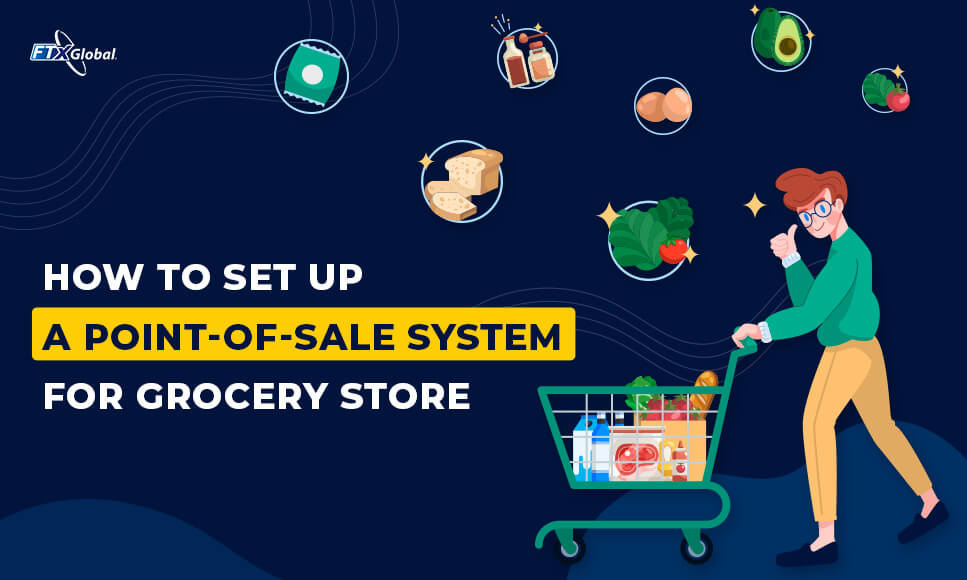
Nowadays, customers are looking forward for a fast, hassle-free and customized shopping experience. This can be achieved through POS Systems, which offer the best solution to fulfill customers demand and offer seamless way of shopping. In this blog, we will discuss the role of POS systems, their significance, how to set up POS systems for a grocery store, and the growing demand for an omnichannel approach combined with POS Systems. Read on to know more.
What is Point of Sale (POS)?
It refers to the place where a customer carries out payment for goods/services in a retail transaction. When a customer walks up the counter or check online to buy an item from your booth/stand, it is counted as the point of sale. A POS can be a physical or virtual place where a sales transaction occurs between a consumer and the buyer. In a store, POS is a place where checkout happens, orders are processed and payment is made.
What is a Point-of-Sale System?
A POS System can be defined as an overall hardware and software system used for billing purposes in an offline store. It comprises units for displaying product weight, total orders made, and other hardware units, namely printer for receipts, cash register and hardware units for barcode scanning. These systems have been around for a while as they are worthy of investment. For this reason, several stores are opting for POS Systems to carry out their routine operations. A good POS system functions as the heart of any online store or business. With these system’s evolution, they have become more effective and are offer considerable benefits to the store owners.
What is the benefit of having a POS System in place?
Having the right POS System for your store or business can help you eliminate manual entries and reporting errors. With a POS system, you can have key insights about your customers, their buying behavior, inventory level and why more supplies should be ordered. There are several benefits of having a POS system, like it automates routine tasks, records daily sales receipts and tracks inventory. Besides it helps streamline your business operations, analyze sales data and automate different processes like inventory control, customer management (loyalty programs), marketing outreach and a lot more.
Following are some useful benefits of POS System for Grocery Store:
- Facilitates inventory tracking
- Enhances customer experience
- Allows retailers to operate from multiple locations
- Assures customer data security
- Offers detailed report on purchase and sales
- Speeds up the product return process
- No-contact contactless transaction
Types of POS Systems
There are 2 types of POS Systems: On-premise & Cloud-based POS Systems. Let’s understand about them in brief:
- On-premise POS System:
Also well-known as traditional or legacy POS, this type of Point-of-Sale system includes both hardware and software. The software is installed and kept on a server located in your physical location. Depending upon your business requirements, you can set up more than one terminal. - Cloud-based POS System:
Also termed a web POS system, the best thing about this system is that it combines both the features and power of an on-premise POS and inherits the benefit of cloud-based storage. It leads to ease of use and makes it more reliable compared to its counterpart. The installation of cloud-based POS takes place in the remote data centers of POS providers. - Open-source POS System:
This type of POS System allows you to modify and customize POS Software as per your specific needs. Even though initially it would be cost-effective, but it needs maintenance and updations over time. Therefore, this type of POS System is ideal for large-size businesses or probably for small-scale businesses, which require more customization. - Omnichannel POS System:
This type of POS System allows you to operate your business across different platforms in either offline or online mode. Data gets synced and updated automatically in real-time to ensure consistency and offer a seamless experience for customers.
POS System for Grocery Store
If you own a grocery store, you would require Grocery Store Point of sale systems that can easily take care of different activities. These activities can handle large volumes of perishable inventory, track and manage store employees and maintain customer loyalty with CRM features. It has been observed that customers tend to spend more when they make any purchase through debit/credit cards, so markets, especially grocery stores, were the early adopters of POS systems.
How can a POS System for Grocery Store Prove Helpful to Grow its Business?
Having the best Grocery Store Point of sale systems is very crucial for the success of your business. POS Systems have great significance when it comes to facilitating payments between several businesses and their customers. Besides, these systems can manage different tasks such as tracking inventory, reading coupons, tracking consumer habits and much more.
Grocery Store POS is a must-have for all store owners who deal in the selling of grocery products. The best thing is that these systems can be integrated with other systems. Having information such as when and which products are being sold can be of great help for businesses to understand consumer behavior and cater to their requirements in the best possible way.
Suppose you are operating a grocery retail store but are not doing business online. In that case, you will face a huge loss as several ubiquitous competitors out there have launched their grocery stores online. But on the contrary, if you are doing business online and are not considering doing business offline, you will not reach offline customers. Therefore, it is necessary to consider both offline and online as an option to do business. In this scenario, the omnichannel solution is the best way to operate a grocery store.
How to set up Grocery store point of sale systems?
- Find the best suitable retail solution provider
Make that the POS system you opt for is the best fit for your business. If it is the best fit, approach a reliable retail solution provider to set up a POS SYSTEM for grocery stores. - Launch the Software & Login
The first thing which is required is to run the software and visit your store’s URL. A web-based software doesn’t not require any installation. If you are using an iPad, you need to download or install the application on your device. You can log in and configure your account accordingly. - Enter/Upload Your Store Products
After creating your account and logging in, you should set up your store’s inventory in your Grocery Store Point of sale systems. For few items, you can choose to enter the data manually into the system, whereas for a large catalog, you need to upload inventory details in bulk. There are modern POS solutions available too, which lets you use a CSV product list to upload inventory information in bulk. - Setting up User Accounts
With POS SYSTEM for grocery store, you can set up profiles/accounts for team members who also use the system. For example, Cashiers, Admins, Store Manager, etc. Set user permission levels to limit them from accessing certain features or information. - Setting up Hardware
Depending on your store setup, the type of equipment you will require may vary. Several devices are available such as barcode scanners, receipt printers, cash drawers, etc. You should consult with your retail solution provider to figure out an ideal device for your store. The basic step to set up involves switching on the device, connecting it to a Wi-Fi network and pairing it to your POS System. - Setting Up POS Software
After setting up the hardware, you need to set up the software too. For this, you can go to the settings menu and configure account settings as per your requirements. You can consider certain things like setting up sales tax rates, third-party integrations, customizing bill receipts with company name, logo, address and other important information like return policy. - Setting Up Payment Methods
After setting up your payment equipment to POS SYSTEM for grocery store, you need to configure software settings to recognize the payment processor. Discuss with your retail solution provider to figure out ideal steps to integrate the POS system with the payment processor. - Integrate Loyalty Programs & CRM
In a POS System, you can register customer information with their photo, address and other essential information like registration of multiple addresses, preferred delivery person, etc. You can also activate built-in loyalty programs, provide redeemable options, customize conversion rates for redeemable points and reward products to consumers. - Connect POS System with other Business Applications
You should integrate your POS SYSTEM for grocery store with apps, which you are already using. You can experience great growth and success in your retail business if the apps you are using are interconnected. You can choose to integrate your POS Software with an e-commerce platform, ERP, accounting software, loyalty programs, etc. If you are not aware of which all are apps you can connect to your POS Software, you can consult with your provider. - Training & Learning of Staff
Several POS providers offer video tutorials and product documentation to train staff members on using the POS system. Step-by-step training videos explain about the whole process such that staff gets an idea about how to use the POS system. Before the training commences, it is suggested to set up a POS system in the manner in which it will be used in the store.
What are Setup Requirements for POS System?
Set up requirements for POS system may vary, as there are several advanced POS systems offered in the market. Some systems are tablet-based and are easy to install compared to their counterparts. Setup instructions for installing a POS system are made available on their official websites. This enables you to decide whether you would be able to set up the POS system yourself or require professional assistance.
Following are hardware requirements for setting up a POS System:
- Cashwrap
- Display screen/touch screen
- Cash drawer
- Customer Facing Displays
- Barcode scanner
- Receipt Printer
- Card Readers
Role of POS System in Inventory Management POS for Grocery Store
Manually tracking and managing your inventory is a difficult task, which is tedious and time-consuming. Using the right POS SYSTEM for grocery store for inventory management is one of the best decisions a grocery store owner can make. If they don’t have a POS system in place, they would be unaware about the status of their inventory and chances are that inventory might become obsolete.
Using a POS system, you can speed up the checkout process. With a centralized database of your products, pricing and customers, you can quickly search for the products, assign a particular order to a customer and apply discounts easily. The best thing about having a POS system is that you can efficiently reduce the chance of customers leaving your store without purchasing anything. POS SYSTEM for grocery store can eliminate the need to stand in a queue for a long time to complete their purchases.
Following are noteworthy benefits of using POS Systems for inventory management:
- Tracks inventory level
It helps keep track of inventory so that you can know which products to order. Maintaining appropriate inventory levels helps in reducing buying costs too. - Generates reports automatically
You can generate sales and inventory reports for any time period and get a fair knowledge about sales performance and inventory levels - Increases business profitability
When ordering inventory costs get reduced, it helps increase business profitability - Handles remote management
If a store has multiple locations, the owner need not worry about inventory theft or anything pertaining to inventory as the POS system keeps track of it - Dynamic inventory management
The use of POS systems allows the business owner to make use of a perpetual inventory system
Follow Omnichannel Approach for Setting Up a POS System
Engaging customers through the digital revolution has become the current trend among stores worldwide. Internet, digital communication, online ordering facility and social media have created a huge impact on how customers perceive and experience any brand. Omnichannel is all about engaging customers wherever they are and offering them excellent shopping experience at every touch point. These touch points can be mobile phone, website, brick-and-mortar store, mobile app, online marketplaces, email, catalog, social media or chat/push notification/mobile message.
Traditional POS has its limits, but with omnichannel POS systems, it’s a different ball game together. Omnichannel POS systems too have tools and software solutions that offer single stock display across different sales channels, integrate product information and stock levels, update online catalogs. They offer flexible fulfillment options like ‘Buy Online, Pickup in Store’. This allows you to offer a rich and personalized shopping experience to your customers.
The omnichannel approach will soon blur the lines between an online and offline shopping experience. With it, your customers can have a hassle-free shopping experience and can leave the store satisfied with their purchases. Grocery stores need to adjust themselves to the advanced developments and should develop an integrated omnichannel strategy to integrate essential solutions with sales channel integration. This will help them achieve effective brand visibility and offer added value to their customers over their counterparts.
When stores follow the omnichannel strategy, they are sure to offer their customers the best digital experience, whilst enriching brand image and offering personalized service to their customers via employees connected online.
Having actionable data can help a business to understand about its strong areas and where it is lacking. It is important to have a complete visibility of the entire buying process/journey of a customer for every stage. This is where omni-channel retail management comes into the picture.
Benefits of Omni Channel Approach for Grocery Store POS
There are 5 key benefits of going omnichannel with POS SYSTEM for grocery store:
-
-
- Increased Customer Loyalty
It helps keep track of inventory so that store owners can know which products you need to order. This helps in reducing buying costs.
By adopting an omnichannel approach, grocery stores can retain customers by giving them the freedom to shop from multiple channels. It paves way to customized shopping experience and increased customer satisfaction too. - Price Flexibility
Customers are ready to shell out more money if the seller offers them a customized buying experience. This means grocery stores can offer the best quality of products and high level of customer service without worrying about costs. This will pave way for great possibilities for creating pricing strategies. - Increased Profits
Offering the best customer experience can result in a great business and on your revenue too. With an omnichannel strategy, you can improve customer experience and in turn, can attract customers and do great business. - Inventory Management
As omnichannel POS Systems share stock-related data across multiple channels, it avoids the risk of inventory being stagnant for a long period of time. It helps in effective inventory management and lets you know the current status of inventory. - Upsell/Cross-Sell Opportunities
With an omnichannel strategy, customers can get access to data, grocery stores can send emails, text, push notifications and direct mail of recommendation upgrades and complementary items.
- Increased Customer Loyalty
How to Create an Omnichannel Strategy POS for grocery store?
The first step to set up an omnichannel strategy is to integrate your online store with a POS System. E-commerce platforms and online stores use POS systems to process orders, manage inventory and track sales data. With e-commerce POS integration, online businesses or stores can boost their sales and revenue. An omnichannel strategy helps in enhancing customer shopping experience in a remarkable way.
As per Harvard Business Review, about 73% of consumers use multiple channels to purchase any product throughout the whole purchase cycle. As per study conducted by Harvard on 46,000 customers, omnichannel customers will buy more than single-channel customers. With an omnichannel shopping experience, online stores and businesses can increase sales, attract more customers and offer the best customized shopping experience. POS Software integration with e-commerce paves the way for omnichannel. Ecommerce POS integration helps in managing all online and offline stores and helps in delivering personalized shopping experience.
Why You Should Bank on FTx POS Systems?
-
-
- Easy to use be, it front-end or back-end
- Order, sales and inventory management from a single portal
- Delivers contactless billing and payment experience
- Enhances customer experience and builds brand awareness
- Tracks, records and analyzes business transactions
- On-demand integrated payroll and accounting management services
- It has features like age verification, confirmation and age requirement for store retailers like cigar, tobacco, liquor and vape
- We offer omnichannel assistance for online businesses
- Specialized POS systems for different states with different laws
- ID scanner comes integrated into our POS systems to automatically scan driver’s license
- Helps in detecting fake IDs
- Automated layout to have control on the amount of information you want to share with users of the POS system
- Training of staff via video tutorials and step-by-step documentation to use POS system
- Get 24 x 7 technical support for your queries
-
Final Thoughts
Store owners should consider investing in an efficient POS SYSTEM to manage their routine tasks in a seamless way. It is essential for grocery store owners to embrace the benefits of omnichannel approach and POS Systems. It will help them maintain a competitive edge and offer the best shopping experience to customers. Thus, POS systems help simplify process of routine tasks for grocery store owners.
-

Subscribe for Newsletter
Be aware of all sales and news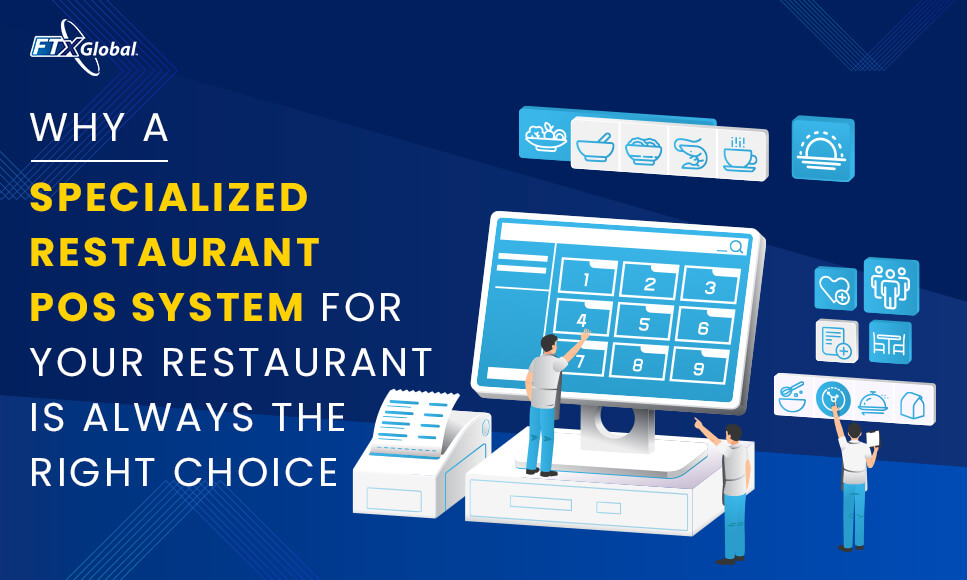
To stay ahead of your competitors, it is essential to have a nice ambience and offer great experience to customers in your restaurant. Other factors to consider is quality service, cleanliness, hygiene, food quality, lighting, décor choices, choice of music played, etc. But all this means nothing if you don’t have a restaurant POS system, an important sales and operations tool.
If you don’t have restaurant POS, you will lose on upsell opportunities, customer service and overall revenue. Often, when purchasing a new POS for a restaurant, one of the common mistakes restaurant owners make is buying a retail POS system for restaurants designed for retailers instead of opting for a restaurant-based POS system. Let us gain an understanding about this system in detail.
What are Restaurant POS Systems?
These POS systems allow restaurant owners to effectively manage inventory tracking, kitchen order tracking and ease the restaurant billing process. An effective POS system helps in effective planning, measures food cost, reduces wastage, pilferage and enhances customer engagement.
Retail POS Systems vs. Restaurant POS System
Even though Retail POS is a great tool to use, but it is ideal for retail store owners. If you own a restaurant, you should use restaurant POS systems. Retail POS systems have basic features, but your restaurant needs more than it.
How Restaurant POS systems are reliable than retail POS systems?
- Table Management: A retail POS system will not offer table management, whereas if you own a restaurant, you will require a restaurant POS system for table management.
- Online Order: With the retail point of sale systems, you will have to pay a portion of every order to third-party online ordering sites. Why share your profits when you can use restaurant-based POS systems that can easily integrate right into your system.
- Analytics: What sold the best today? Which server made the most tips? Only a restaurant- based POS system can answer all the related questions that a restaurant owner wants to know.
- Customer Database: Who are your regular customers? Which food do they love the most? With the help of a restaurant POS system, you can keep track of your valuable clients with an integrated loyalty program and database that reflects customer purchase trends.
- Relevant Add-on Integrations: From managing inventory, employee scheduling, gift cards, sales, loyalty points or customer database everything can be managed from just one restaurant POS system. The same can’t be handled by retail POS systems.
What difference can restaurant owners observe with restaurant POS Systems?
-
Improve Customer Relationship
With the help of a POS solution, you can deliver customer satisfaction, thereby enhancing customer experience. With restaurant-based POS Systems, you can change food menus as per season, weekends or regular days, occasions, events, etc. Besides this, you can also reduce waiting time and offer multiple payment options for customers. POS systems lead to quick, better and improved service, which leads to great customer satisfaction.
-
Reduce Waiting Time
There are different counters for food items like appetizers, desserts, salads, main course, etc. Customers might order for a variety of food items from separate places. This type of instance demands proper synchronization; as it might confuse waiters and lead to serving wrong orders. With a restaurant POS system, you can integrate multiple servers in a single line. It further helps in allowing fast order processing, improves table management and on-time food delivery. This reduces waiting time and enables restaurants to increase the efficiency of operations, customer satisfaction and serve more customers.
-
Enhances Kitchen Efficiency
The journey from the customer to the kitchen can be reduced with a restaurant-based POS system. When you use a cloud-based POS system, the waiter can send customer orders directly to the kitchen without wasting time. The to and fro can be reduced to a great extent, which makes customer service the main focus point of the server.
-
Manage Recipes & Inventory
In your restaurant POS system, you can map your ingredients to recipes. It reduces wastage & pilferage and helps in accurate inventory management, especially during multiple deliveries. With a restaurant POS system, you can efficiently manage stock and provide accurate and updated snapshots of available items.
-
Automated Menu Display
Menu forms an important part of any restaurant. Before ordering food online about 75% of customers check menu details. When you visit any restaurant, you are handed a food menu as soon as you arrive at a table, isn’t it? It can get sorted with the help of a POS system. You can create a visual menu display for your customers. Customers can quickly view the menu, so this will save both customers and staff time.
-
Accept Online Orders & Track Orders 24 x 7
By using a restaurant-based POS system, you can serve customers anywhere be it restaurant, office or home. It has become a common trend among foodies to order food online and relish it in their comfort zone. You can integrate your restaurant POS system with multiple online ordering channels to track orders 24×7. In this way, you can capture customer’s data and update the same with the CRM database. It might happen that customers may have queries regarding your restaurant or food quality, so you can answer questions using this software. It leads to customer satisfaction and helps to create a positive impression on their minds.
-
Table Management & Reservation
With a restaurant POS system, you can manage table orders and the reservation process. Customers can place orders via a mobile phone or tablet. You can track booking information by making use of this feature in an accurate manner. It also gives owners an idea about how many tables are empty. This is the most vital feature to know to achieve profit and grow your sales.
-
Labor Management
As per stats, about 75% of restaurant owners need management feature to manage their labors effectively. With the help of a POS system, they can easily track labor’s activity, attendance and work hours. It helps owners to understand how their staff has utilized their time and help in assessment of paying salary, further recruitment or dismissal. Lastly, this system allows your staff to maintain their timing properly.
Over to You
To carry out routine transactions, a retail POS system is suitable. But when it comes to managing a restaurant, nothing can beat the efficiency and relevancy of the best POS system for restaurant. Restaurant point-of-sale systems are designed for betterment of restaurant industry. Thus, these systems allow restaurant owners access useful insights and enhance operations in a way that helps them do better business.

Subscribe for Newsletter
Be aware of all sales and news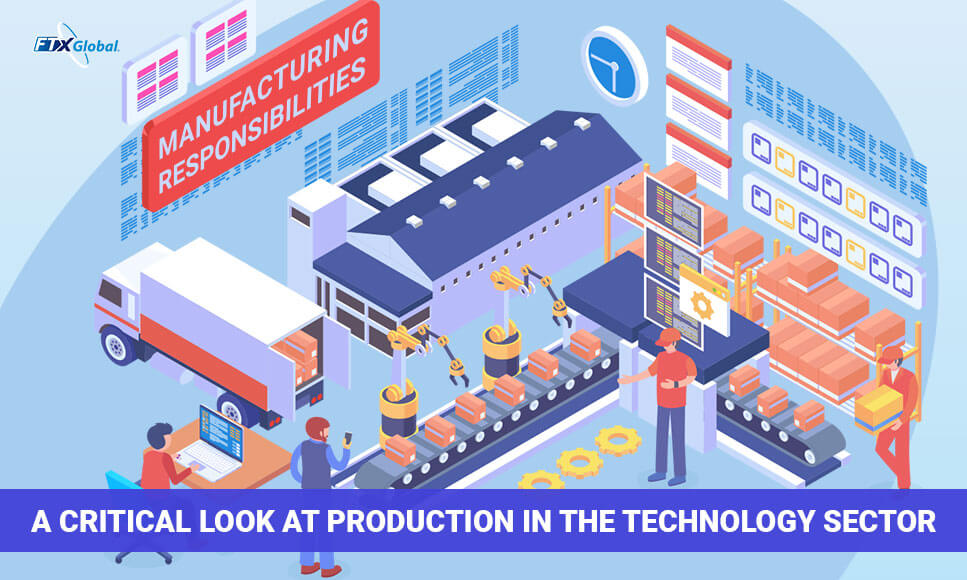
With FasTrax Warehouse, you can achieve complete inventory management of your different warehouse locations. It helps you track your inventory accurately and automate routine warehouse operations. Snapshots of daily inventory allows you to run reports on your own schedule. Having a track of quantity available on order & on hand for any product.
Let FasTrax Warehouse manage all tasks pertaining to inventory. Know more about how FasTrax Warehouse and how it aids in tracking technology devices, equipment inventory and automates routine distribution warehouse operations.
New cloud warehouse management software features help business owners maintain warehouses, manufacturing facilities and engineering plants.
Today, manufacturers are making a concerted effort to greatly reduce the quantities of inventory items they store in their warehouses. Warehouses, therefore, are evolving into “flow-through” or “cross-docking” facilities. This means that companies like yours could be in the throes of restructuring manufacturing-to-warehousing workflows so that your finished & packaged tech products enter one side of the warehouse, are reconfigured into shipments, and then are immediately moved out into delivery trucks on the other side of the warehouse.
High-performance warehouses have adopted this model and cross-dock 50% or more of their manufactured goods. No matter how fast the flow-through becomes, warehouses will be used for storage. Though the tech devices you produce can be “made-to-order”, it reduce consuming warehouse space, but it is not possible to avoid storing inventory altogether. Warehousing will be required for the foreseeable future, and the most successful technology manufacturers have made the necessary adjustments in their warehouses to meet the reduced need for space and increased complexity of order-fulfillment turnarounds.
Have you made the necessary adjustments, too? If so, does your warehouse inventory software have the depth and functionality to reflect this new, streamlined, and fast workflow?
Even if you have made the necessary adjustments, you will still require warehouses management software to provide supply-chain flexibility. You must have a “shock absorber” in place. What specific “shocks” will your warehouse need to absorb? The first issue occurs when customers request product modifications after your facility has already built and fulfilled their tech device orders. This could clog up the workflow and storage system of your warehouse. Secondly, the business relationships you maintain regarding your manufacturing could fluctuate. Your contract to purchase ferrite from China, for example, could expire, forcing you to purchase the same metal from another supplier. This relocation and shift in supply-chain activities more often falls on the warehouse personnel to track and manage. You will require a warehouse management software to record every exception to rule, no matter how much your supply chains are affected.
The lines between manufacturing and warehousing have blurred within the technology production industry. This blur has impacted warehouse employees the most in that they now face serious challenges, including:
- Pressure to decrease manufacturing & warehousing costs
- Greater corporate & customer expectations for accuracy
- Ongoing efforts to reduce warehoused inventory by means of issuing postponement programs, consolidating warehouse facilities, and focusing on cross-docking programs
- Strategies to streamline workflow and minimize inventory
- Accommodating electronic & online orders with same-day shipping
- Perform manufacturing units to prevent goods from being sent back to the manufacturing plant
Your company will have to upgrade its warehousing & inventory software in order to meet these new challenges and evolve into full-blown distribution centers that are equipped to predict and record inventory movement as efficiently as possible.
A warehouse management software should be customizable as warehouses are not limited for inventory storage. If your company has gone beyond warehousing, and doubles-up as a kitting and assembly hub, then the software used at your facility must reflect your real-life workflow.
With customized warehousing in place, technology product manufacturing plant can speed up their assembly and delivery process. It can be achieved while maintaining your core engineering and manufacturing autonomously. Opt for inventory software that has warehouse automation and operations like picking, barcode labeling, and other technology-infused features. It will help reduce human error and speed up order-fulfillment times.
Does your manufacturing company offer end-to-end product services such as prototyping, patenting, designing, engineering, crowdfunding, and marketing? Your software needs to be able to handle every facet of your business.
Manufacturing factory and warehousing facilities offer the full gambit of products and services to customers including sourcing, inspecting, assembling, and quality control. It means that you need comprehensive functionality from your warehouse inventory software. Your customers trust you because you are an industry leader in prototyping and engineering technology equipment and devices. For this reason, you should use the best inventory software solution to take care of all of your operational needs.
Technology product manufacturing company offering end-to-end technology development for consumer devices that include Internet-of-Things and products like Smart Devices, and Tech Wearables should opt for FasTrax Warehouse Inventory Software. The software accommodates your complex business needs. It offers accurate and comprehensive reporting that help you make faster and wiser project decisions.
FasTrax Warehouse gives you complete control of your inventory, no matter how many warehouse locations you have. Price lists assigned to account group simplify invoice and accounting with a warehouse software. Daily inventory snapshots allow you to run reports as per your schedule. Our proprietary software allows you to view item quantities at any time, be on-hand or ordered with your vendors.
Let FasTrax Warehouse management software handle the heavy lifting of your inventory management! Click here to learn how FasTrax Warehouse can track your technology devices & equipment inventory, and automate your daily distribution warehouse operations.
Learn more about FTx Global and what our services can do for you by visiting our website.

Subscribe for Newsletter
Be aware of all sales and news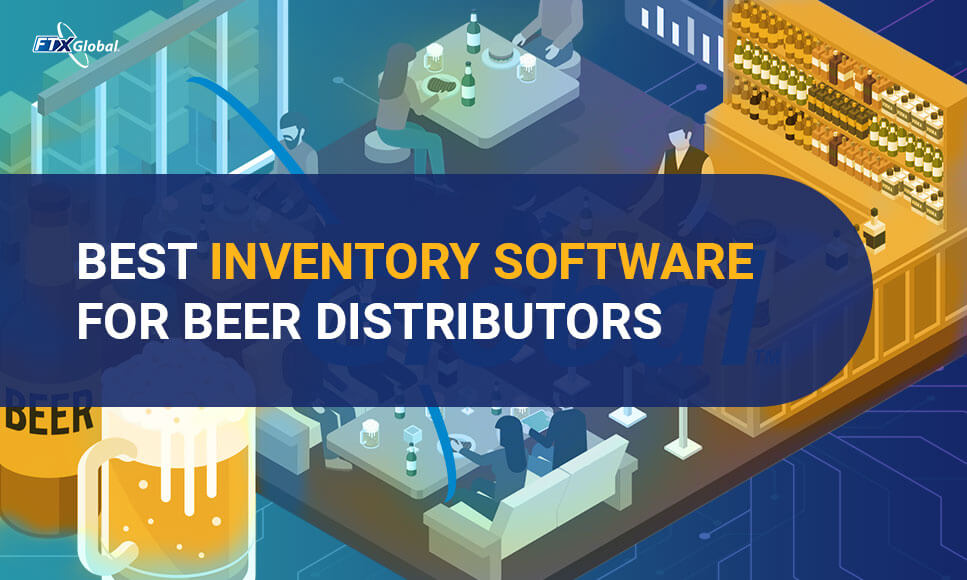
FTx Global (FasTrax Warehouse, Alcohol Industry)
At a basic level, managing your beer distribution operations can either be effective or insufficient. Effective distribution management will result in business growth, but becoming effective might be trickier than it sounds. Ask yourself, are any of the following common pitfalls familiar?
- Your retail inventory management software or IMS, is restricted to multiple data points rather than a single source of inventory information. You can’t even answer a customer’s question or set accurate reorder points as you can’t see the big inventory picture on a single screen.
- Your warehouse management software, or WMS, is a contributing enabler of your warehouse workers taking too long to pack inventory, pick inventory, and put away inventory.
- You have not streamlined your warehouse layout which has resulted in delayed customer deliveries and increased labor costs because workers are scrambling to fulfill orders.
- Your transportation management system, or TMS, is either literally or essentially non-existent. This has resulted in your inability to access real-time information about carrier rates or choose the most optimal trucking route to lower shipping costs without delaying orders and deliverables.
- Your WMS and TMS have never been integrated or if they have the end result is piecemeal nonsense that you rarely look at.
FTx Warehouse Management System Software
If you answered “yes” to even one of these pitfalls, then your entire warehouse management is subprime. When it comes to retail warehouse inventory management and the workflow of your entire beer distribution facility, you probably already know that one weak link can compromise the entire chain. If you answered “yes” to all of those pitfalls, then you have a serious problem on your hands, one which could cost you big bucks.
An excellent distribution management strategy generates value across the beer distributor’s entire supply chain. It empowers you to monitor your distribution efforts. You should gather data about how well your beer brands are moving from warehouse to the retailers, who are your customers, you can leverage and take action on this data. Most importantly, when effective retail inventory management software is in place at your distribution center, you will easily spot operational bottlenecks, identify weak workflows, and be able to easily improve inefficient processes that slow your workers down and drain your finances.
What is the fastest way to eliminate those problems and get on the fast track to success? You need to implement warehouse inventory software at your facility that exercises an empowering distribution management strategy. View the entirety of your beer distribution business, no matter how many warehouse locations you have, at the click of a button and on a single screen.
Select the best warehouse inventory software which is designed by taking into consideration warehousing and distribution center. It should provide specific, measurable, and immediate benefits to your business. The software should also provide the following shortcuts:
- Successfully fulfill customer orders
- Deliver customer value consistently
- Quickly adapt to market changes
- Quickly respond to potential disruptions
- Boost the bottom line
FasTrax Warehouse gives you complete control over your beer inventory, no matter how many warehouse locations you have. Price lists should be assigned to customers and customer account groups for faster accounting. Daily inventory snapshots allows you to run reports on your own schedule. And using our proprietary software allows you to view on-hand item quantities at a glance.
FasTrax Warehouse can also:
- Assign price lists to account groups that easily correlate with customer accounts
- Our Price Lists software supports tax and margin percentage pricing to help you clearly assess your bottom line. You can add and discount base prices by percentage or dollar, you remain in control
- Location-picking features come with up to 10 location levels for items. Our pick sheets and handheld wireless devices allow your staff to quickly pick orders and eliminate unnecessary trips to the warehouse floor
- Our software solution comes with EDI support so that you’re never alone navigating the collection and routing of electronic transactions
Let FasTrax Warehouse handle the heavy lifting of your inventory management! Click here to discover how FasTrax Warehouse can accurately track your beer inventory and automate your daily distribution warehouse operations.
Learn more about FTx Global and what our services can do for you by visiting our website.

Subscribe for Newsletter
Be aware of all sales and news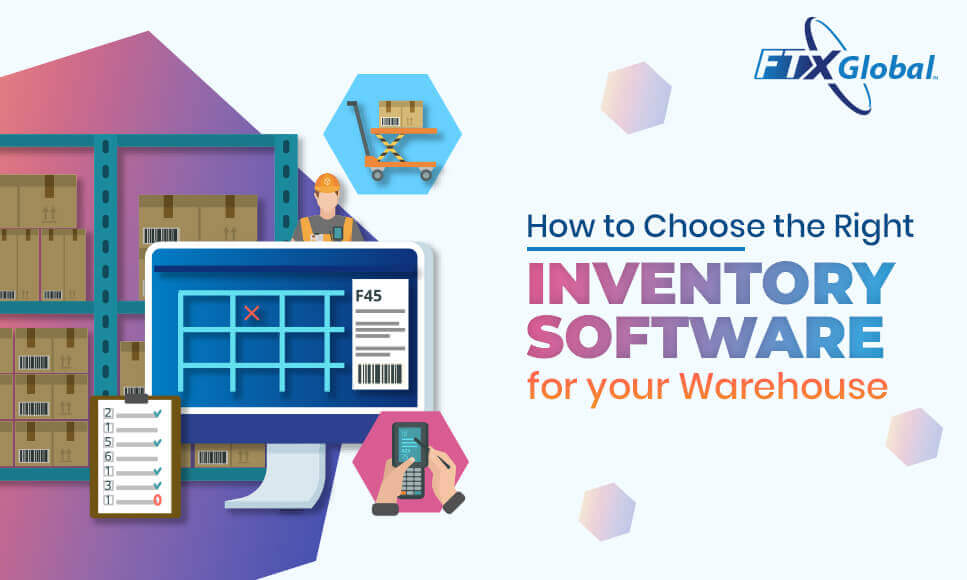
FTx Global (FasTrax Warehouse, Inventory Software)
Warehouse technologies have been rapidly evolving. Improving efficiency, diversifying operations, and offering lightning-fast fulfillment times are important for a company to maintain a competitive edge, attract and retain customers, and make the most of their employees’ time.
Investing in automation is an important aspect of upgrading your warehouse workflow. Companies can get a strong hold on their supply chain management if they employ a warehouse management system that has comprehensive inventory control. Still, you wouldn’t be here if you didn’t know that. So, let’s get an idea about warehouse inventory software characteristics!
We’re going to keep things simple and give you three rules to live by while running your warehouse. If your warehouse inventory software doesn’t support these rules, you might need to upgrade your technology and purchase a solution that does.
Don’t let short shipment holds bog down the entire warehouse
Inventory inaccuracies occur when the quantity of an item received is less than ordered quantity. In the industry, it is termed as “short-shipped” because the receivables were “short” of the expected quantity. Experienced warehouse managers know that late arriving packages are usually the cause of this kind of discrepancy pileup. When short-shipped orders happen, they freeze inventory and warehouse workflow bottleneck and truncate the whole warehouse’s ability to fulfill other orders.
Using a detail and real-time warehouse inventory software system, differences can be found out and reconciled; rather than holding your warehouse’s entire inventory. Your fulfillment systems can still move forward with orders not associated with the SKU items.
Normalize adjustment codes across inventory pools
No matter what size your company is, it will grow over time, whether it occupies one or several warehouse locations. When companies use different warehouses in various locations even across several states the inventory tracking becomes exponentially more complex. Each warehouse location has its inventory pool to track, but being the company owner, you should know what the total inventory is any time you choose.
The answer to this challenge includes using intuitive inventory software that normalizes inventory codes across all warehouses as part of your overall maintenance routine. Normalizing codes provides a better idea of the items that are potentially available and helps forecast fulfillment of an order.
Connected inventory-adjustment system
Be sure to pick warehouse inventory software with a simple and centralized management tool to help you identify shipment holds and sync inventory adjustment codes. You need to be able to easily and efficiently manage any changes therein. This is the most important way to improve short-shipped rates. Ensure all warehouse databases and other inventory processing systems are connected and working in the right order to highlight inventory discrepancies and avoid inventory issues.
By this point, you’re probably convinced of the importance of all the features we’ve gone over, but do you know which software to choose?
FasTrax Warehouse gives you a complete control over inventory, no matter how many warehouse locations you have. Price lists are assigned to account groups to assign them to customer accounts easily. Daily inventory snapshots allow you to run reports as per your schedule. Our proprietary software shows the quantity available on order and on hand for any item.
FasTrax Warehouse
- Assign price lists to account groups and correlate them to customer accounts
- Our Price Lists software supports tax and margin percentage pricing to help you see your bottom line clearly. You can add and offer discount on base price by percentage or dollar; you remain in control
- Location picking comes with up to 10 location levels per item. Our pick sheets and handheld wireless devices allow efficiently pick orders and reduce unnecessary trips around the warehouse floor
- Our software solution comes with EDI support so that you’re never alone navigating the collection and routing of electronic transactions
Let FasTrax Warehouse handle the heavy lifting of your inventory management! Click here to learn how FasTrax Warehouse can accurately track your inventory and automate your daily warehouse operations.
Discover all of the services that FTx Global offers and partner with us today.



